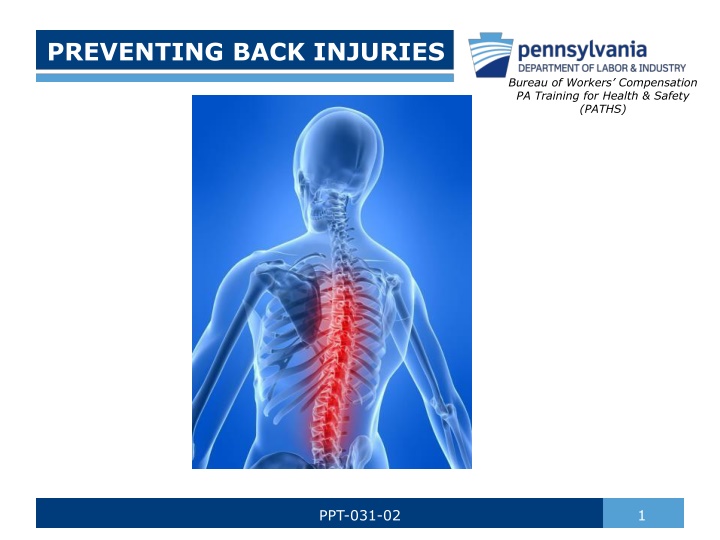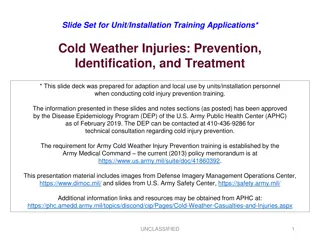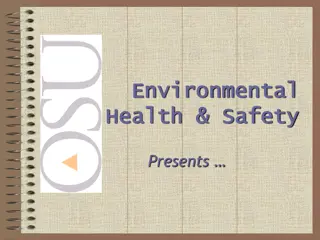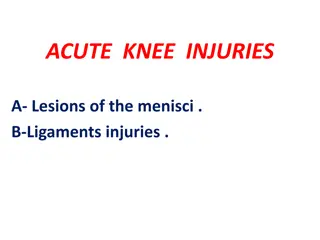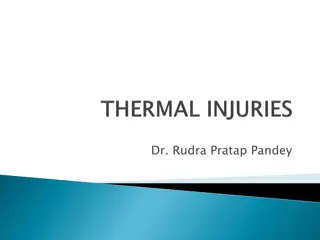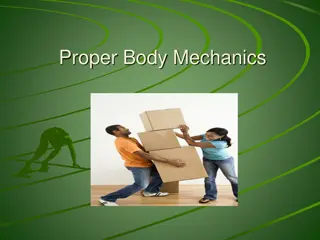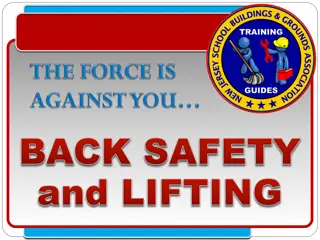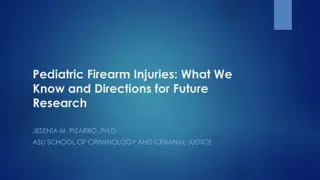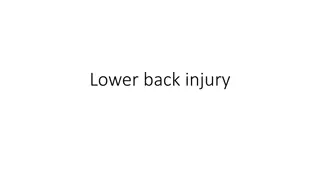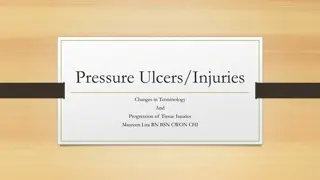Preventing Back Injuries: A Comprehensive Guide
Back injuries are common in workplaces, with 80% of Americans expected to suffer from them. This guide emphasizes the importance of warm-up, proper job task execution, and back strengthening. It includes information on the structure of the back, lifting techniques, and steps to prevent injuries, such as planning ahead, route assessment, and proper lifting posture.
Download Presentation

Please find below an Image/Link to download the presentation.
The content on the website is provided AS IS for your information and personal use only. It may not be sold, licensed, or shared on other websites without obtaining consent from the author.If you encounter any issues during the download, it is possible that the publisher has removed the file from their server.
You are allowed to download the files provided on this website for personal or commercial use, subject to the condition that they are used lawfully. All files are the property of their respective owners.
The content on the website is provided AS IS for your information and personal use only. It may not be sold, licensed, or shared on other websites without obtaining consent from the author.
E N D
Presentation Transcript
PREVENTING BACK INJURIES Bureau of Workers Compensation PA Training for Health & Safety (PATHS) PPT-031-02 1
Back Injuries Back injuries are one of the most common and costly workplace injuries. It is estimated that 80% of all Americans will suffer from back injuries. Preventing back injuries can be as simple as taking a few minutes to warm up, evaluating and properly performing job tasks, and strengthening your back at home. Most back pain is mechanical, meaning people have increased pain with particular motions of their backs. Most mechanical back pain is not caused by a slipped or ruptured disc. PPT-031-02 2
The Back The back is composed of small bones, called vertebrae, that are stacked on top of each other. Between the vertebrae are fibrous discs that provide padding and cushion shocks. Nerves run down the center of the vertebrae and muscles hold it all together PPT-031-02 3
Lifting & Proper Body Mechanics Proper posture and body mechanics can help to protect your body, especially your back, from pain and injury. Back pain is usually the result of a number of contributory factors. Poor posture and faulty body mechanics are generally involved. PPT-031-02 4
Plan Ahead Before moving a load it is important to plan both the load and the route. This allows you to evaluate hazards, limitations, route safety, and final placement of the load. When considering the load evaluate the weight, shape, and material it is made of. PPT-031-02 5
Route and Placement Check the route you will take and the place where you will set the load down. Many injuries and considerable property damage can occur when unexpected problems are encountered during the move. PPT-031-02 6
Lifting Properly All loads should be lifted with the back in the most natural, upright position. The load should be approached so that you can avoid twisting while lifting and with the body over the load as much as possible. Ask for help whenever you think you might need it. PPT-031-02 7
Proper Lifting Approach the load Face the load so you won t have to lift and turn. Point your feet in the direction you will be taking the load before lifting. Grasp the load Squat over the load with your knees bent and the load between your legs as much as possible. Grasp the load with the whole hand. Wear gloves! PPT-031-02 8
Proper Lifting Carry the load Lead with your feet as you carry the load. Turn slowly with your legs. Do not turn your back. Place the load Put the load down with the same care used to pick it up. Plan your approach to avoid twisting or reaching forward with the load in your hands. PPT-031-02 9
Lifting Reminders Squat to lift and lower. Do not bend at the waist. Keep your lower back bowed in while bending over. Keep the weight as close to you as possible. PPT-031-02 10
Lifting Reminders Bow your back in and raise up with your head first. If you must turn, turn with your feet, not your body. Put the weight down by keeping your lower back bowed in. Never jerk or twist. PPT-031-02 11
Lifting Reminders Keep your feet apart, staggered if possible. Wear shoes with non-slip soles. Try to keep frequently used items within arms reach. Don't try to stretch for things above your head or out of reach. PPT-031-02 12
Back Injury Prevention Three Key Components Proper posture Conditioning Body mechanics PPT-031-02 13
Posture Proper posture includes standing and sitting in an upright position without: slouching, rounding of the shoulders or accentuating the natural curves of the spine. Poor posture typically involves holding the head too far forward or allowing the belly to pull the back forward. Get in the habit of holding in the belly to keep it from protruding and putting excess force on the spine. PPT-031-02 14
Conditioning Proper conditioning involves overall conditioning of the body and cardiovascular system with aerobic exercise. Also strengthening and stretching core muscles of the spine and abdomen. Walking, swimming, bicycling, and slow, short distance running are excellent ways to condition the entire body and improve cardiovascular health. PPT-031-02 15
Body Mechanics Body mechanics refers to the way we use our bodies to complete various tasks during activities of daily life. When lifting, bending or stretching, think of how you are using your back to avoid provoking an acute injury. There may be a simpler, less strenuous method or posture that can be used to get something done. PPT-031-02 16
Body Mechanics Instead of bending at the back to pick things up off the floor, stoop down at the knees. Keep the back as straight as possible and maintain proper posture. Instead of reaching overhead, use a sturdy stepstool. Push or pull with your entire body, not just your arms. Wear comfortable, low-heeled shoes. When working, whether sitting or standing, pace your activities and take frequent breaks. PPT-031-02 17
Exercise for a Healthy Back Wall slides to strengthen your muscles . . . . Stand with your back against a wall, feet shoulder-width apart. Slide down into a crouch with knees bent to 90 degrees. Count to 5 and slide back up the wall. Repeat 5 times. NOTE: Before beginning ask your family doctor if you re able to safely do the exercises shown PPT-031-02 18
Exercises for a Healthy Back Straight Leg Raises . . . . Lie on your back with legs straight. Tighten abdominal muscles to stabilize low back. Slowly lift leg straight up about 6 to 12 inches and hold 1 to 5 seconds. Lower leg slowly. Repeat 10 times. PPT-031-02 19
Exercises for a Healthy Back For more exercises talk with your physician or a Physical Therapist. PPT-031-02 20
Dont Become a Statistic Preventing back injuries can be simple! Common sense, planning, exercise, and good judgment can enable you to do your job without injury and allow you to go home at the end of your shift instead of lying in a hospital bed in pain. Don t be a statistic, think before you lift! PPT-031-02 21
Contact Information Health & Safety Training Specialists 1171 South Cameron Street, Room 324 Harrisburg, PA 17104-2501 (717) 772-1635 RA-LI-BWC-PATHS@pa.gov Like us on Facebook! - https://www.facebook.com/BWCPATHS PPT-031-02 22
Questions PPT-031-02 23
